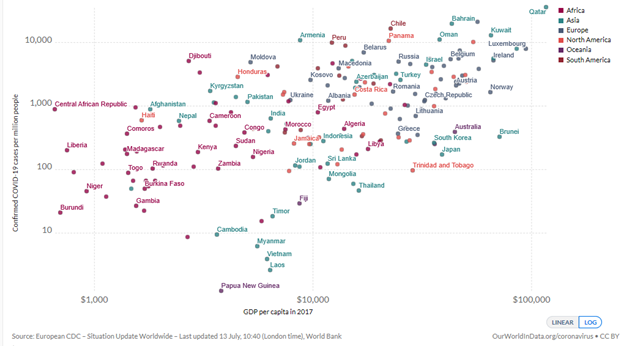Covid Act Two: Look beyond your borders to navigate what comes next
The six key questions that will determine how successful governments are at navigating the next phase of covid.
-
Date
October 2020
-
Area of expertiseGovernance
-
FeedWEF
-
KeywordPublic Sector Governance (PSG)
Act One of covid-19 is over. In places it has been frightening, in others orderly, and everywhere completely unprecedented. As we move into Act Two of this astonishing global drama, and a global recession on a scale not seen before, governments and leaders need to prepare themselves for what comes next and the big questions that will define whether countries sink or swim.
A defining feature of Act One was the seeming uniformity of the pandemic. It felt like the whole world was brought together by a shared experience – fighting a merciless enemy that swept the world and respected no language or national boundary. This feeling was also often matched by a striking uniformity of response – regardless of context, governments in almost every country pulled the lockdown lever to suffocate and slow the virus.
With the curtain coming down on Act One, we find ourselves wondering: was this uniformity of experience real or imagined? It may have been a mirage. Looking closely Act One has been a vastly different experience across countries. Whereas Europe and the US have seen massive caseloads, the predicted tsunami in Africa has yet failed to materialize, even after acknowledging the lack of data. In other places like Pakistan or Indonesia the crisis looks set to smoulder, with periodic flare ups. This divergence belies the impression of uniformity – an impression that may have had more to do with where headlines are generated than any true homogeneity of experience. The reality of covid has been extremely heterogenous.
This brings us to Act Two. So far, the policy debate has focused on how to manage the pandemic and economic shocks. The result has been a narrow focus on managing the pandemic and its economic consequences in the present, and within countries’ own borders. As governments move into the recovery phase and start thinking about the subsequent waves, a more nuanced view of the evolving situation must take hold.
In the early stages of this crisis, it was the hyper-connected parts of the world that were impacted most. The more connected a country and its economy were to the rest of the world, the higher and faster the caseload. This is common sense – places with a huge through-traffic of travellers and visitors (like London, New York, Hong Kong), and more infrastructure, had far greater probability of transmission than Lilongwe or Lapland. In Act One, interconnectedness was a risk factor – it created vulnerability as travellers, tourists and flights became disease carriers. And to compound things, interconnected economies have suffered more initially – from loss of exports, loss of remittances, loss of investment. Meanwhile, those places with less inter-connection were sheltered from the storm, or at least suffered a slower spread.
Cumulative confirmed covid-19 cases per million vs. GDP per capita – 13 July

But as the curtain comes up on Act 2, this dynamic may be flipped on its head. The interconnectedness that hurt countries in Act One will now become a huge advantage in Act Two as many countries move into the recovery phase. And those countries whose relative isolation slowed the virus could be hardest hit by the global recession and stranded from the recovery. Take Africa for example – the continent-level exception to the ‘single covid story’. The general lack of connection or internal infrastructure that slowed the virus may find their economies shunned as the virus smoulders there for far longer, leaving them marooned while the rest of the world moves on. This is what happened during Ebola. It may happen again.
Unlike the apparent (although probably false) homogeneity of Act One, Act Two will be a story of increasingly diverse outcomes and policy responses. And the divergence is not just in policy but in time too: some countries are moving into recovery while others will be stuck in cycles of crisis as the virus yo-yos around the country. This staggered timing will hurt those lagging behind – being an early casualty of the virus will turn into an advantage as you move faster into recovery mode.
Leaders: Change your thinking
Above all, in Act One everyone focused on the putting out the fire within their borders. Things are now about to become much more complex. Countries will need to consider national, regional, and international interactions. What is happening within your borders still matters, but the situation in your neighbours, region, trade partners – both epidemiologically and economically - will matter more and more.
In Act Two you need to concern yourself with many more questions. What is happening in countries you share a border with? Or countries where most of your remittances come from? What is happening in countries where your tourists come from? Where your investors come from? What about your main imports? Or places that buy your main exports? Where does your food come from? Where do your migrant workers, or refugees come from?
The answer to each question might deepen your recession, cause second waves of covid, or interact to generate dangerous crises such as food security or conflict.
In Act Two, your analysis and policymaking needs to look at what’s happening around you, not just what’s happening in your own borders, making an already complex situation, infinitely more complex. This requires a step change and a mindset shift. To manage this, governments need to look at the effects of covid-19 in the round, how they interact with each other, and craft scenarios to anticipate emerging risks arising as the pandemic, and its socio-economic impacts, progress.
Building these scenarios does not need to be an impossible task. We think it is important to acknowledge the uncertainty. We would advise leaders and policy makers to focus on six big questions in Act Two.
Within your borders, build on Act One and focus on what you can control:
1. What have been the big constraints to your response, and can you fix them? What has made it difficult for your country to respond? E.g. food security and access; urban living conditions; the informal economy; social protection; behavioural change. What can you do anything about these to improve your resilience to additional waves?
2. Is your health system ready for multiple waves of the virus? What has limited your health response to covid to date? E.g. a lack of community health workers; limited testing; test-and-trace systems. Can you address these limitations? Are you positioned to benefit from trials and rollouts of treatments and vaccines? Are you conducting effective health diplomacy?
3. What do you need to do to bolster your economy? What is likely to continue to make it difficult for your country economically and what can you do about it? E.g. are you still able to import your key needs; are companies still sell what they produce. What can you do to mitigate these impacts?
Beyond your borders, think about the risks that might emerge and how they will impact that actions you take within your country:
4. What is happening in your connected countries on the health front, and how might this impact you? What is happening in your neighbours and most common trade, tourism and travel partners? What are the implications of this? What do you expect the impact to be on your economic and health systems? How effective has the response been in your connected countries? Do they pose a risk to you or you a risk to them?
5. What is happening with your connected countries economically, and how might this impact you? For countries with whom you trade, what is happening in their economy? Are your key imports available, and can you firms sell your key exports? For countries where you have a large Diaspora, or from which a large amount of remittances come, are you engaging your Diaspora? Have you developed a plan for mass influx or exodus? And for falling remittances.
6. What wider risks an opportunities do you need to anticipate and plan for? What regional shifts are happening – for eg are your main trade routes open? How vulnerable is your country, and economy, to extreme weather events (for eg harvests, hydro power)? Are there regional security risks which may be caused by, or exacerbated by, covid trends in your neighbourhood? Are there opportunities for financial relief or diplomacy to help support your crisis response?
No set of questions will cater for every variation in country context. But in preparing for Act Two, it is vital for governments to ask questions both within and beyond their borders. The risks and dangers caused by covid are evolving – beyond health and immediate economic crisis towards much greater complexity and interdependence. In Act Two, governments need to be looking at how the risk factors both within and beyond their borders could interact in different scenarios. This is vital and urgent work, especially for those countries most at risk of being left behind in the post-covid world.
This blog first appeared on the Building State Capability Blog by The Center for International Development at Harvard University.


